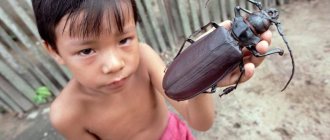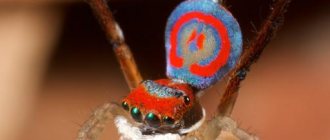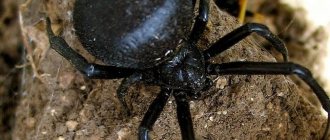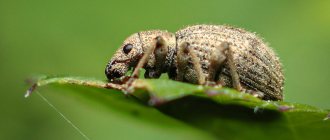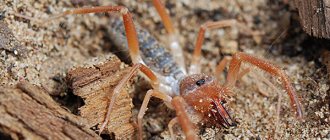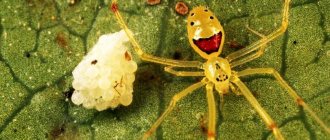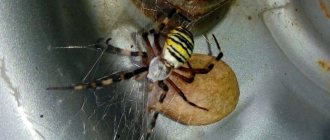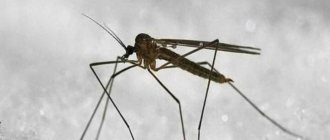Types of spiders in the Rostov region
The south of Russia is home to a huge number of species of spiders. Photos and names of the most prominent representatives are presented below.
Wolf spiders
They lead a solitary lifestyle and prefer active hunting. They look for prey in the trees, among grass, and bushes, and pursue them until a good opportunity presents itself to attack. In search of prey, wolves in the Rostov region often crawl into a person’s home. They do not attack on their own, but they can bite.
Once in the house, the wolf spider does not reveal itself in any way, since it does not weave a web, but hides in corners, behind furniture, cabinets with dishes, shoes, clothes, and rags. The bite will follow after the person, without noticing the spider, crushes it.
Swelling, redness, swelling, and pain appear at the site of the bite. People with an increased tendency to allergies may experience a general deterioration in their health. Treatment is local, systemic antihistamines. The symptoms and pain are reminiscent of a wasp or bee sting.
The body size of females, together with the leg span, reaches 3 cm; males are always several times smaller. The usual color is gray-brown. The limbs are long and powerful. There are stains of a darker color all over the body.
Wolf spider and karakurt
Karakurt
Poisonous spiders of the Rostov region. Medium-sized predators. The female reaches a size of 20 mm, males - 7 mm. The color is bright and shiny. The abdomen and cephalothorax are black with 13 red spots. The legs are long and black. Adults often change color after molting, becoming glossy black.
The main habitats are wastelands, virgin lands, and ravine slopes. Dangerous spiders are nocturnal and hunt insects and small arachnids. Karakurt is extremely prolific. Approximately once every 12 years, a massive outbreak of reproduction occurs. The eggs are laid by the female in a self-formed cocoon; in this state, the larvae remain overwintering.
Karakurts in the Rostov region are non-aggressive, they bite when their own life is threatened. The consequences vary in severity. A person feels a deterioration in well-being within 15 minutes:
To stop the pathological process, the introduction of serum or a combination of drugs - calcium chloride, novocaine, sodium hydrogen sulfate is required.
Krestoviki in the Rostov region
They live everywhere. Can be found in the forest, in the vegetable garden, garden, clearing, abandoned premises. The description of the appearance can be different - gray, brown, beige, ashen. A characteristic feature of this type of spider is the presence of a pattern on the upper part of the abdomen in the form of a cross.
Predators destroy a large number of pests in the Rostov region and regulate the number of insects. They are nocturnal, but prefer sunny meadows. They weave huge trapping nets. At night this process takes at least an hour. During the day they sit in the center of the web or hide in a secluded place, stretching a signal thread there.
Crosses have the peculiarity of getting into things, bags, and shoes of people vacationing in nature. A man takes his things without noticing the spider and gets bitten. The toxic substance is dangerous for insects and causes a local allergic reaction in humans. The pain goes away within a week. In some cases, weakness, nausea, and dizziness appear. In such cases, local, systemic antihistamines are used.
Serebryanka in the Rostov region
The only spider that has adapted to live in water. Silverfish are found in stagnant bodies of water. They build nests under water and feed on crustaceans and insect larvae. There are special extensions at the end of the legs that allow spiders to swim well under water.
Mating takes place in the female's house, the male lives there for some time. Inside, the female forms a cocoon where she lays her eggs. After the cubs appear, the mother continues to care for them for some time. After the first moult, the spiders climb out and build their houses in the immediate vicinity.
The description of the appearance does not differ from other types of arachnids - cephalothorax, convex abdomen. The peculiarity of this type is the presence of a special lubricant that creates air bubbles on the body. Thanks to this feature, it seems that the body is covered with silver and glows.
The silverfish bites painfully, but not fatally. A severe allergic reaction occurs at the site of the bite. Weakness, dizziness, poor health, and abdominal pain also appear. It goes away within a few days.
The list of large spiders in the Rostov region can be continued endlessly, since there are a lot of them. You can meet an arachnid in your own home, sitting on a cobweb in the corner of the room, in the yard, outbuildings, or in the country. Predators do not pose a danger to humans if you keep your distance from the spider.
Source
Furry tarantulas crawl into the entrances of Rostovites
This spider is scary to look at - it is shaggy, usually large in size (about the size of a matchbox), behaves provocatively: it “rears up” and even jumps. This is a South Russian tarantula.
Is it poisonous? The fact is that there are practically no non-venomous spiders on earth. Science knows only one species of some exotic spider that feeds on dew. All other spiders are carnivorous. And since their digestive system is very different from ours, spiders first need to bite their victim (better said, BITE), inject nerve poison, then saliva with a special substance that corrodes the insides of the victim. That is, all spiders have poison, even the most primitive domestic ones to which we are all accustomed. So arachnophobes have cause for concern.
Another thing is that the overwhelming number of spiders are not dangerous for people: some simply cannot pierce thick human skin with their chelicerae, others sense danger and simply run away from the huge monster - man.
But the south is the south, and in our area there are some pretty dangerous spiders. The most dangerous of all is the karakurt. Its bite can be fatal. But the bite of a scary-looking tarantula in its consequences, if a person is not allergic to the poison of this particular arachnoid, is similar to the bite of a bee or wasp. Which, of course, is also unpleasant. Especially if the bite increases the horror that many experience in front of arachnoids.
Yes, this spider is poisonous, its bite is painful, but never fatal. Besides, if you don’t tease him (and he jumps!) and generally disturb him, but just carefully sweep him into a dustpan and take him out, nothing will happen. You just need to overcome yourself and your fear.
In recent days, several messages have appeared on social networks: tarantulas are crawling into houses and even into the entrances of citizens.
Those who still remember the vacant lots in Rostov know that boys used to catch tarantulas in two ways: they put a piece of plasticine or resin on a thread, lowered it into a hole, teased the spider, and when it grabbed the “tackle”, dug into it with its chelicerae, pulled it to the surface . Then they organized spider “fights” and exterminated these, in general, harmless arachnoids.
The second method is to fill the mink with water. After a while, the spider, tired without air, crawled out of there on its own.
Apparently, the downpours that periodically hit Rostov force these spiders to crawl out of their burrows and look for a place where it is warm and dark. This place could also be the entrance to a high-rise building.
A month will pass and all the arachnoids will go into hibernation. If you see it now, don’t press it, take it out into the front garden on a scoop, let it dig a hole there and fall asleep in the winter. But there will be fewer harmful insects on the site.
Vladimir Sidashev
Birds
Storks
White stork (Ciconia ciconia) - an understudied species
Yellow heron (Ardeola ralloides) - endangered species
Karavaika (Plegadis falcinellus) - vulnerable species
Spoonbill (Platalea leucorodia) - an endangered species
Black stork (Ciconia nigra) - a critically endangered species
Copepods
Dalmatian pelican (Pelecanus crispus) is an endangered species
Little Cormorant (Phalacrocorax pygmaeus) - vulnerable species
Pink pelican (Pelecanus onocrotalus) - a critically endangered species
Passeriformes
Gray Shrike (Lanius excubitor) - Vulnerable
Black lark (Melanocorypha yeltoniensis) - a critically endangered species
Loons
European black-throated loon (Gavia arctica arctica) - vulnerable species
Anseriformes
White-eyed Pochard (Aythya nyroca) - an endangered species
The red-breasted goose (Rufibrenta ruficollis) is an endangered species
Little swan (Cygnus bewickii) - vulnerable species
Lesser Lesser White-fronted Lesser White-fronted Goose (Anser erythropus)
White-headed duck (Oxyura leucocephala) - a species on the verge of extinction
Gray duck (Anas strepera) - endangered species
Woodpeckers
Green woodpecker (Picus viridis) - an understudied species
Middle spotted woodpecker (Dendrocopus medius) - vulnerable species
Crane-like
Bustard (Otis tarda) - a species on the verge of extinction
Demoiselle crane (Anthropoides virgo) - vulnerable species
Crake (Porzana pusilla) - an understudied species
Common crane (Grus grus) - vulnerable species
Little Bustard (Tetrax tetrax) - an endangered species
Charadriiformes
Avdotka (Burhinus oedicnemus) - a species on the verge of extinction
Great godwit (Limosa limosa) - vulnerable species
Great Curlew (Numenius arquata) - a critically endangered species
Oystercatcher (Haematopus ostralegus longipes) - vulnerable species
Glareola pratincola - vulnerable species
The Little Tern (Sterna albifrons) is an endangered species.
The sea plover (Charadrius alexandrinus) is an endangered species
The porcupine (Tringa stagnatilis) is an understudied species.
Curlew (Numenius phaeopus) - an endangered species
Steppe tirkushka (Glareola nordmanni) - an endangered species
Slender-billed curlew (Numenius tenuirostris) - a critically endangered species
Stilt (Himantopus himantopus) - restored and recovering species
Chegrava (Hydroprogne caspia) - vulnerable species
Black-headed gull (Larus ichthyaetus) - vulnerable species
Avocet (Recurvirostra avosetta) - vulnerable species
Owls
Great-footed owl (Aegolius funereus) - vulnerable species
Falconiformes
Saker falcon (Falco cherrug) - a species on the verge of extinction
Griffon vulture (Gyps fulvus) - vulnerable species
Golden eagle (Aquila chrysaetos) - vulnerable species
Greater Spotted Eagle (Aquila clanga) - a critically endangered species
European tuvik (Accipiter brevipes) - an endangered species
The snake eagle (Circaetus gallicus) is a critically endangered species
Buzzard (Buteo rufinus) - vulnerable species
Lesser Spotted Eagle (Aquila pomarina) - vulnerable species
The common honey buzzard (Pernis apivorus) is a vulnerable species.
Pygmy eagle (Hieraaetus pennatus) - vulnerable species
Imperial Eagle, or Karagush (Aquila heliaca) - a species on the verge of extinction
White-tailed eagle (Haliaeetus albicilla) - restored and recovering species
Peregrine falcon (Falco peregrinus) - an endangered species
Osprey (Pandion haliaetus) - a critically endangered species
Steppe kestrel (Falco naumanni) - a species on the verge of extinction
Steppe Harrier (Circus macrourus) - a critically endangered species
Steppe Eagle (Aquila nipalensis) - vulnerable species
Lifestyle of the South Russian tarantula
Mizgir tries to lead a secretive lifestyle. It is active in the evening and at night, but if there is a lack of food or during the breeding season, it can remain awake during the day. The lifespan of a spider in nature is 2 years. Most of the time it is in a hole, the depth of which can be up to 30-40 cm. Mizgir digs such a tunnel on its own. Inside the spider's home is lined with cobwebs; there are no additional passages or holes.
The South Russian tarantula leads a solitary lifestyle. He protects his territory from his relatives and, if necessary, enters into a fight. Such fights often end in the death of one or both participants.
Hunting
As mentioned earlier, the Mizgir hides in a hole most of the time. In this case, the predator suddenly jumps out of cover when prey approaches. Most often it kills the victim with one bite, but in rare cases it can attack again. The South Russian tarantula determines the location of its prey by its shadow. Thanks to this, the spider can be easily lured outside.
The diet of this arthropod includes:
- insects;
- small species of spiders;
- frogs;
- baby mice.
However, the basis of the spider’s diet is insects. The predator will attack other prey presented in the list only when there is a shortage of food.
Reproduction
The Mizgir mating season begins in August. At this time, males stop hunting and go in search of females. When they meet, they begin to quickly and chaotically move their abdomen and forelimbs. If the female is ready to mate, she responds with the same movements. Otherwise, the female perceives the male as a threat and prey, which is why the latter is forced to run away and hide. The female behaves similarly after mating. Unlike many other species of spiders, male South Russian tarantulas manage to escape relatively often.
Fertilized females hide in their burrows for the winter. As the weather gets warmer, the eggs mature. In this case, the parent weaves a cocoon, which it attaches to its own abdomen. The female lays about 50 eggs there. The female fiercely guards her offspring, holding them with chelicerae if necessary.
The offspring that emerge from the eggs are not able to gnaw through the cocoon on their own. The parent helps them with this. A distinctive feature of this type of arachnid is that newborn spiders climb onto their mother and remain under her care for some time. As they grow older, they scatter in random directions.
Reptiles and amphibians
The herpetofauna of the Rostov region is distinguished by its special species diversity; it has 27 species - 13 species of reptiles and 14 species of amphibians.
Of the reptiles in the region, there is 1 species of turtle, 4 species of lizards and 8 species of snakes: marsh turtle (Latin: Emys orbicularis), multi-colored foot-and-mouth disease (Latin: Eremias arguta), sand lizard (Latin: Lacerta agilis), striped lizard (Latin: Lacerta strigata), viviparous lizard (lat. Zootoca vivipara), common copperhead (lat. Coronella austriaca), yellow-bellied snake, or Caspian snake (lat. Dolichophis caspius), patterned snake (lat. Elaphe dione), four-striped snake, or Palasov (lat. Elaphe quatuorlineata), lizard snake (lat. Malpolon monspessulanus), common snake (lat. Natrix natrix), water snake (lat. Natrix tessellata), steppe viper (lat. Vipera ursinii). The Red Book of the Rostov Region includes the multi-colored foot-and-mouth disease in the “Rare” category, the yellow-bellied snake, the four-striped snake, the patterned snake, the common copperhead and the steppe viper in the category “Declining in numbers.”
Of the amphibians, 1 species of salamander, 2 species of newts, 2 species of toads and 9 species of frogs have been recorded: Caucasian salamander (lat. Mertensiella caucasica), crested newt (lat. Triturus cristatus), common newt (lat. Lissotriton vulgaris), green toad (lat. . Bufotes viridis), common or gray toad (lat. Bufo bufo), red-bellied toad (lat. Bombina bombina), common spadefoot toad (lat. Pelobates fuscus), common tree frog (lat. Hyla arborea), lake frog (lat. Pelophylax ridibundus), pond frog (lat. Pelophylax lessonae), edible frog (lat. Pelophylax esculentus), grass frog (lat. Rana temporaria), sharp-faced frog (lat. Rana arvalis), Asia Minor or Caucasian frog (lat. Rana macrocnemis) . The Red Book of the Rostov Region includes the common newt in the category “Endangered” and the sharp-faced frog in the category “Uncertain status.”
Fish
The ichthyofauna of the Rostov region includes 1 species of lampreys and 72 species of bony fish (except for purely marine fish that occasionally enter the Taganrod Bay, which are usually not found there) from 16 orders and 20 families.
Species are categorized into orders and families. Order Sturgeon, family Sturgeon: Russian sturgeon, sterlet, beluga, stellate sturgeon. Order Salmonidae, family Salmonidae: salmon. Order Herring-like, Herring family: Don herring, Azov herring, bellyfish, sprat; Anchovy family: anchovy. Order Mullet-shaped, family Mullet: mullet, singil. Order Atheriniformes, family Atherinaceae: arterina. Order Flounder, family Flounder: river flounder. Order Pike-like, family Pike: common pike. Order Eels, family River eels: river eel. Order Cypriniformes, family Cyprinidae: roach, ram, carp, common dace, Danilevsky dace, chub, ide, rudd, kalinka (bobyrets), asp, verkhovka, tench, Volga podust, whitefin gudgeon, Azov-Black Sea shem, bleak, bystryanka, silver bream, bream, white-eye, bluefish, fisherman, saberfish, bitterling, golden crucian carp, silver crucian carp, carp; Loach family: loach, spined loach; Balitoriaceae family: baleen loach. Order Catfish, family Catfish: common catfish. Order Codlike, family Burbot: burbot. Order Sticklebacks, family Sticklebacks: three-spined stickleback, small southern stickleback. Order Needlefish, family Needlefish: Black Sea plump-cheeked needlefish. Order Perciformes, family Perchaceae: common ruff, Don ruffe (privet), river perch, common pike perch, bersh, percarina; Goby family: Azov goby, Black Sea goby, sand goby, round goby, tsutsik goby, Shirman goby, colt goby, messenger goby, bubyr goby, Caspiozoma goby, Knipovich's long-tailed goby. Order Lampreys, family Lampreys: Ukrainian lamprey.
To reproduce, the Russian sturgeon leaves the Black Sea and rises up the Don.
15 species of fish and 1 species of cyclostome are included in the Red Book of the Rostov region: Ukrainian lamprey, sterlet, stellate sturgeon, beluga, Russian sturgeon, white-eye, Azov-Black Sea shemaya, Volga podust, kalinka, Danilevsky dace, common dace, whitefin gudgeon, carp, golden crucian carp, loach, caspiosa goby.
